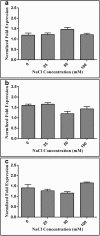Achromobacter sp. FB-14 harboring ACC deaminase activity augmented rice growth by upregulating the expression of stress-responsive CIPK genes under salinity stress
- PMID: 31820296
- PMCID: PMC7203246
- DOI: 10.1007/s42770-019-00199-8
Achromobacter sp. FB-14 harboring ACC deaminase activity augmented rice growth by upregulating the expression of stress-responsive CIPK genes under salinity stress
Abstract
Soil salinity is one of the major plant growth and yield-limiting constraints in arid and semi-arid regions of the world. In addition to the oxidative damage, increasing salt stress is associated with elevated cellular ethylene levels due to the synthesis of 1-aminocyclopropane-1-carboxylic acid (ACC) in large amounts. The objective of the current study was to elucidate the inoculation effect of an ACC deaminase (ACCD)-producing phytobeneficial strain Achromobacter sp. FB-14 on rice plants to alleviate the salinity effects by upregulation of the stress-responsive CIPK genes. The strain FB-14 was isolated by using nutrient agar medium at 855 mM NaCl concentration and it was taxonomically identified as Achromobacter sp. with more than 99% 16S rRNA gene sequence similarity with many Achromobacter species. The strain FB-14 demonstrated substantial in vitro potential for ACCD activity, synthesis of indole compounds, and phosphate solubilization up to 100 mM NaCl concentration in the culture medium. The gene corresponding to ACCD activity (acdS) was amplified and sequenced in order to confirm the inherent enzyme activity of the strain at a molecular level. The rifampicin-resistant derivative of strain FB-14 was recovered from the rice rhizosphere on antibiotic medium up to 21 days of sowing. Moreover, the strain FB-14 was inoculated on rice plants under salinity and it not only enhanced the growth of rice plants in terms of root and shoot length, and fresh and dry weight, but also upregulated the expression of stress-responsive CIPK genes (OsCIPK03, OsCIPK12, and OsCIPK15) according to the results of qRT-PCR analysis. To the best of our knowledge, this is the first report deciphering the role of plant-beneficial Achromobacter strain relieving the rice plants from salt stress by promoting the growth and enhancing the expression of stress-responsive CIPK genes.
Keywords: ACC deaminase; Gene expression; PGPR; Rice; Salt tolerance.
Conflict of interest statement
The authors declare that they have no conflict of interest.
Figures





Similar articles
-
Enhancement of growth and salt tolerance of rice seedlings by ACC deaminase-producing Burkholderia sp. MTCC 12259.J Plant Physiol. 2018 Dec;231:434-442. doi: 10.1016/j.jplph.2018.10.010. Epub 2018 Oct 12. J Plant Physiol. 2018. PMID: 30414570
-
Salt-tolerant plant growth-promoting Bacillus pumilus strain JPVS11 to enhance plant growth attributes of rice and improve soil health under salinity stress.Microbiol Res. 2021 Jan;242:126616. doi: 10.1016/j.micres.2020.126616. Epub 2020 Oct 9. Microbiol Res. 2021. PMID: 33115624
-
A halotolerant Enterobacter sp. displaying ACC deaminase activity promotes rice seedling growth under salt stress.Res Microbiol. 2018 Jan;169(1):20-32. doi: 10.1016/j.resmic.2017.08.005. Epub 2017 Sep 9. Res Microbiol. 2018. PMID: 28893659
-
Plants Saline Environment in Perception with Rhizosphere Bacteria Containing 1-Aminocyclopropane-1-Carboxylate Deaminase.Int J Mol Sci. 2021 Oct 24;22(21):11461. doi: 10.3390/ijms222111461. Int J Mol Sci. 2021. PMID: 34768893 Free PMC article. Review.
-
ACC deaminase in plant growth-promoting bacteria (PGPB): An efficient mechanism to counter salt stress in crops.Microbiol Res. 2020 May;235:126439. doi: 10.1016/j.micres.2020.126439. Epub 2020 Feb 15. Microbiol Res. 2020. PMID: 32097862 Review.
Cited by
-
Exploring the Impact of Coconut Peat and Vermiculite on the Rhizosphere Microbiome of Pre-Basic Seed Potatoes under Soilless Cultivation Conditions.Microorganisms. 2024 Mar 14;12(3):584. doi: 10.3390/microorganisms12030584. Microorganisms. 2024. PMID: 38543634 Free PMC article.
-
Achromobacter sp. FB-14 mediated morpho-physio-biochemical and molecular improvements in cotton subjected to salt stress.BMC Plant Biol. 2025 Aug 19;25(1):1095. doi: 10.1186/s12870-025-07183-5. BMC Plant Biol. 2025. PMID: 40830769 Free PMC article.
-
Genomics and taxonomy of the glyphosate-degrading, copper-tolerant rhizospheric bacterium Achromobacter insolitus LCu2.Antonie Van Leeuwenhoek. 2024 Jul 23;117(1):105. doi: 10.1007/s10482-024-01989-3. Antonie Van Leeuwenhoek. 2024. PMID: 39043973
-
Role of ACC-deaminase synthesizing Trichoderma harzianum and plant growth-promoting bacteria in reducing salt-stress in Ocimum sanctum.Physiol Mol Biol Plants. 2023 Jun;29(6):815-828. doi: 10.1007/s12298-023-01328-2. Epub 2023 Jun 23. Physiol Mol Biol Plants. 2023. PMID: 37520812 Free PMC article.
-
Plant growth-promoting Bacillus sp. strain SDA-4 confers Cd tolerance by physio-biochemical improvements, better nutrient acquisition and diminished Cd uptake in Spinacia oleracea L.Physiol Mol Biol Plants. 2020 Dec;26(12):2417-2433. doi: 10.1007/s12298-020-00900-4. Epub 2020 Nov 19. Physiol Mol Biol Plants. 2020. PMID: 33424156 Free PMC article.
References
-
- Birla DS, Malik K, Sainger M, Chaudhary D, Jaiwal R, Jaiwal PK. Progress and challenges in improving the nutritional quality of rice (Oryza sativa L.) Crit Rev Food Sci Nutr. 2017;57(11):2455–2481. - PubMed
-
- Sarkar A, Pramanik K, Mitra S, Soren T, Maiti TK. Enhancement of growth and salt tolerance of rice seedlings by ACC deaminase-producing Burkholderia sp. MTCC 12259. J Plant Physiol. 2018;231:434–442. - PubMed
-
- Chen CY, Mei HC, Cheng CY, Lin JH, Chung YC. Enhancing the conversion of organic waste into biofertilizer with thermophilic bacteria. Environ Eng Sci. 2012;29(7):726–730.
-
- Zafar S, Ashraf MY, Anwar S, Ali Q, Noman A. Yield enhancement in wheat by soil and foliar fertilization of K and Zn under saline environment. Soil Environ. 2016;35(1):46–55.
-
- Heydarian Z, Yu M, Gruber M, Glick BR, Zhou R, Hegedus DD. Inoculation of soil with plant growth promoting bacteria producing 1-aminocyclopropane-1-carboxylate deaminase or expression of the corresponding acdS gene in transgenic plants increases salinity tolerance in Camelina sativa. Front Microbiol. 2016;7:1966. - PMC - PubMed
MeSH terms
Substances
Grants and funding
LinkOut - more resources
Full Text Sources

